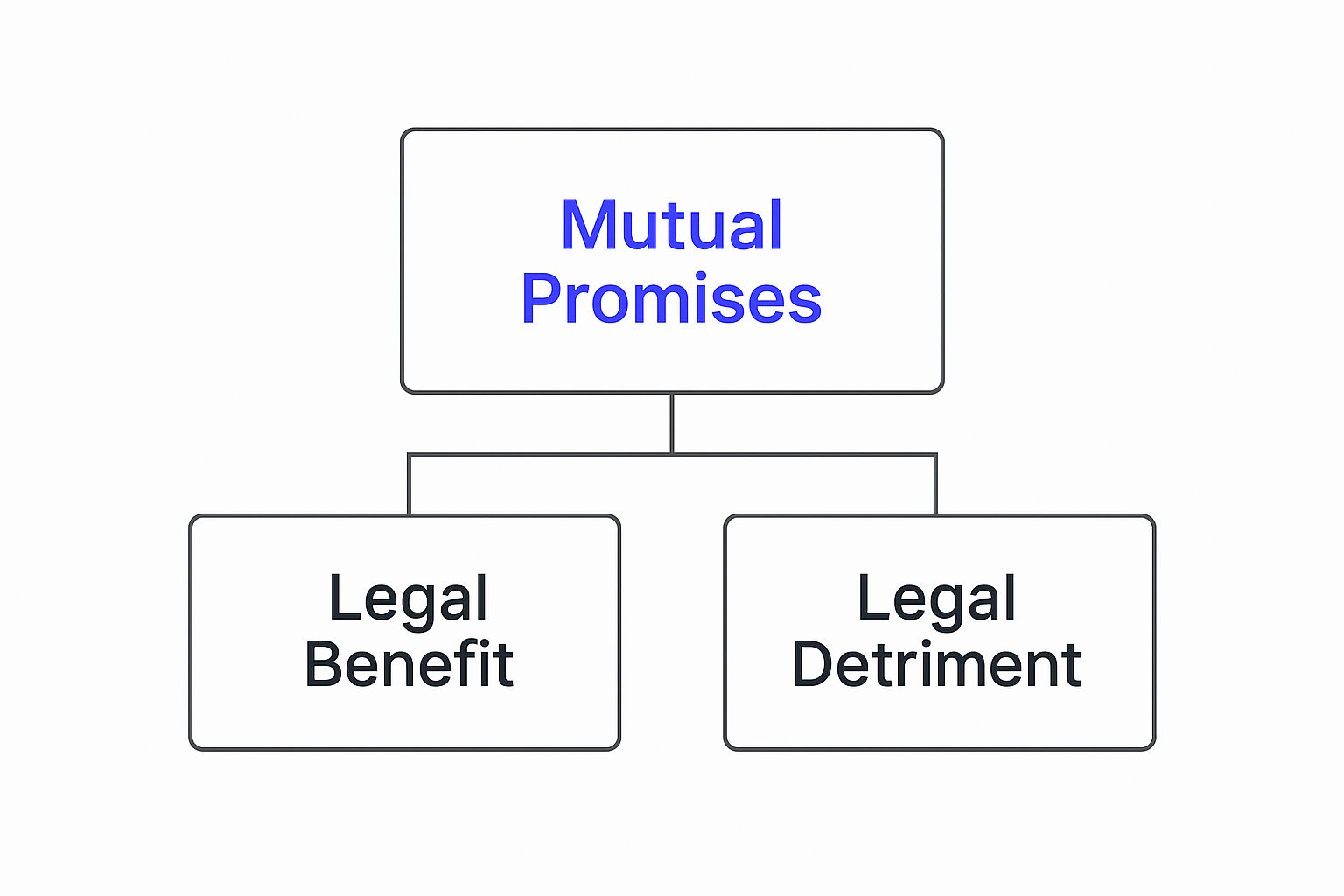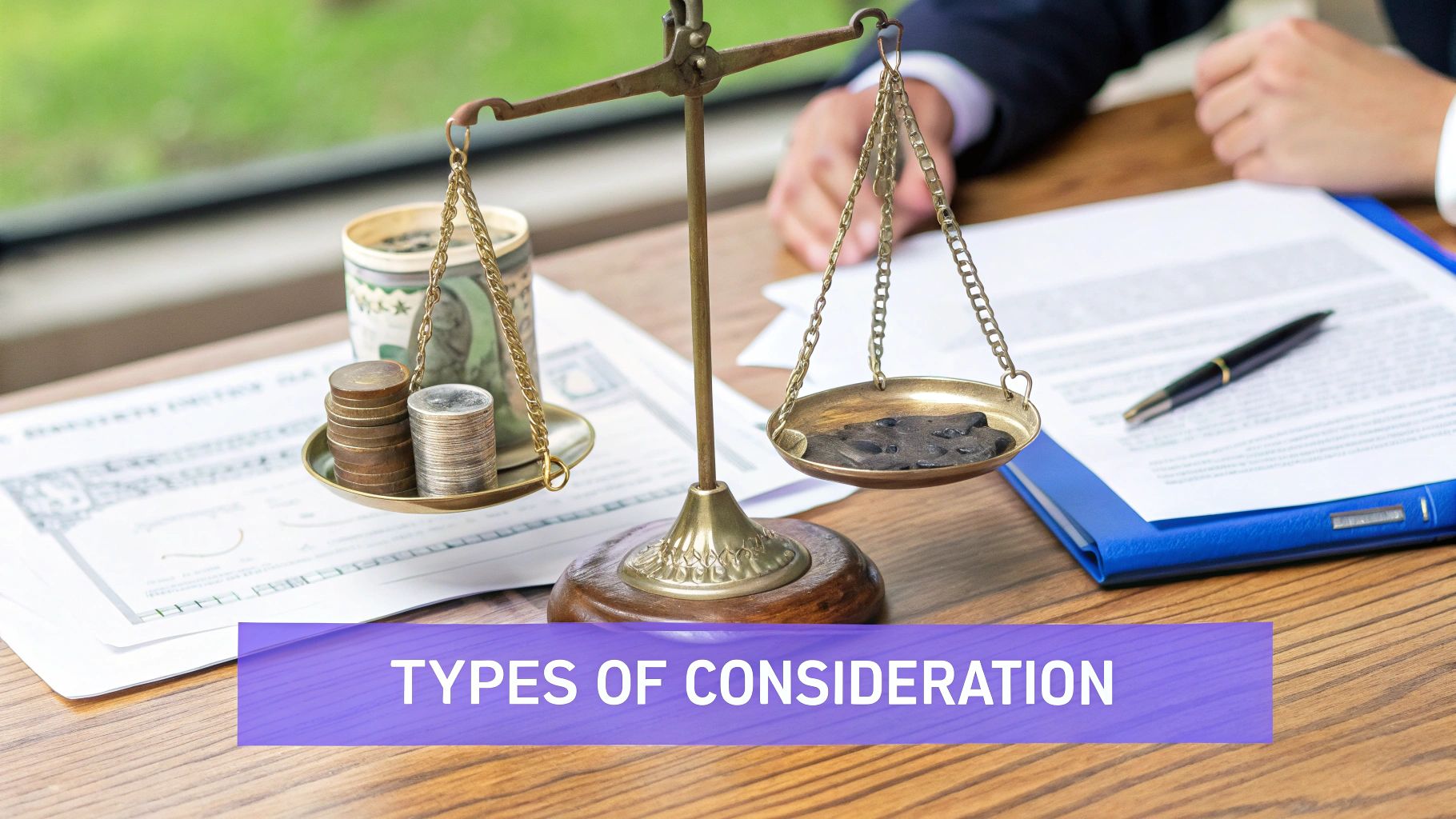
Contract consideration is the heart of any legally binding agreement. Think of it as the "price" each person pays for the other's commitment. It’s the mutual exchange of value—something given for something received—that elevates a simple promise into an enforceable deal. Without it, you just have a casual, non-binding pledge.
What Is Consideration in a Contract?

At its core, consideration is all about the bargained-for exchange. This doesn't necessarily mean a drawn-out negotiation took place, but simply that each party's promise prompted the other to act.
Let's use a simple, everyday example: buying coffee. You hand the barista money (that's your consideration), and they hand you a freshly brewed coffee in return (that's their consideration). This mutual give-and-take is what makes the transaction a contract.
This two-way street is the bedrock of contract law. If it's missing, you're left with a one-sided promise, which the law typically views as a gift. For instance, promising to give your friend $100 for their birthday isn’t a contract because your friend isn't giving you anything of legal value in return. It’s this lack of reciprocity that separates a flimsy promise from a solid business agreement.
The Foundation of an Enforceable Deal
For any contract to hold up in court, consideration must be present. The law sees it as the promise, performance, or even the act of refraining from doing something that one party bargains for in exchange for their own promise.
Why is this so important? This requirement ensures that contracts aren't formed carelessly. The law wants to see that both parties have some "skin in the game." This achieves several important things:
- It proves intent: Requiring an exchange shows that both sides were serious about creating a legal relationship.
- It prevents unfairness: It stops one person from being legally tied to a promise while the other has zero obligation.
- It creates clarity: The nature of the exchange helps define the scope and purpose of the agreement itself.
Ultimately, getting a firm grip on this concept is vital for anyone drafting or signing an agreement. You can dive deeper into this fundamental topic by reading our detailed guide on what is a consideration.
To make this even clearer, here's a quick reference table breaking down the essential components of consideration.
Quick Guide to Contract Consideration
| Component | Simple Explanation | Example |
|---|---|---|
| Promise to Act | A commitment to do something in the future. | A painter promises to paint your house next month. |
| Performance of an Act | Actually doing something right now. | You pay the painter a 50% deposit on the spot. |
| Forbearance | Agreeing not to do something you have a legal right to do. | Your neighbor agrees not to build a tall fence that would block your view, in exchange for a payment. |
| Bargained-for Exchange | The promises must be mutually induced. | Your promise to pay the painter is the reason they promise to paint, and vice versa. They are linked. |
This table neatly summarizes how different forms of value can create a legally sound contract, moving beyond just the exchange of money for goods.
The Elements of Legally Valid Consideration
For a contract to actually hold up in court, the "consideration"—what each person exchanges—has to meet a couple of key legal standards. Courts don't just see that something was swapped; they look closely at how it was swapped. This boils down to two critical components: legal value and a genuine bargained-for exchange.
Let's start with legal value, because it's a concept people often get wrong. It has very little to do with market value or fairness. You might have heard of the "peppercorn theory" of consideration—and it’s a real thing. In principle, a contract could be legally binding even if a sprawling estate is exchanged for a single, symbolic peppercorn, as long as that peppercorn was a genuine part of the deal. The court isn't there to save you from a bad bargain, only to confirm that a bargain was actually made.
The Bargained-For Exchange Explained
This leads us to the second, and arguably more important, element: the bargained-for exchange. This is the real heart of consideration. It means that what one party promises or does is the direct reason the other party makes their promise or takes their action.
Think about hiring someone to build a deck. You promise to pay them because they promise to build it. Their promise to build is given because you promise to pay. The two promises are directly connected, forming a two-way street of obligation.
Key Takeaway: The whole point of a bargained-for exchange is that the promises aren't just happening at the same time by coincidence. One person's commitment is the motivation for the other's. This mutual inducement is what separates a binding contract from a simple, unenforceable promise to give a gift.
This diagram shows how these mutual promises create a benefit and a detriment for everyone involved.

As you can see, each party gets something they want (a legal benefit) but also gives something up (a legal detriment). That push-and-pull is the bedrock of a valid exchange.
Spotting Invalid Promises
Once you understand this idea of mutual inducement, you can start to spot promises that look like consideration but fall flat. Two classic examples are illusory promises and promises based on a pre-existing duty.
Illusory Promise: This is a statement that sounds like a commitment but is actually hollow. For example, "I'll pay you $500 for your services if I feel like it." Since the payment is completely optional, the promise is an illusion. There's no real obligation, so there's no consideration.
Pre-existing Duty: You can't offer something you're already legally required to do as new consideration. Imagine a police officer trying to claim a cash reward for catching a thief. It won't work. Catching criminals is already their job—their pre-existing duty—so they can't use that same action to form a new contract for the reward money.
Making sure your agreements are built on a genuine, bargained-for exchange of legal value is how you create a contract that's not just a piece of paper, but a legally enforceable commitment.
Exploring Different Forms of Consideration

When we hear "contract," most of us immediately picture money changing hands for goods. That’s definitely a common type of deal, but the concept of consideration is much more versatile than just cash. In reality, it can take on several different forms, and each one can create a perfectly valid and legally binding agreement.
Getting a handle on these variations is crucial. It helps you spot potential deals and protect your own interests, whether you're navigating a complex business negotiation or a simple personal arrangement. The "value" exchanged doesn't have to be tangible. It can be a promise, an action, or even a promise not to do something.
This very flexibility is what makes contracts so powerful, allowing them to underpin everything from massive corporate mergers to a simple agreement with a local freelancer. The main way we categorize consideration is by looking at when the value is actually exchanged.
Executed vs. Executory Consideration
The biggest difference between types of consideration comes down to timing. Is the promised act already done, or is it scheduled for the future? This splits consideration into two camps: executed (the act is complete) and executory (the parties are trading promises for future acts).
Let’s say you prepay a caterer for a wedding. From your side, that’s executed consideration—you've already performed your part of the bargain. The agreement as a whole, however, with your payment and their promise to provide food later, is executory. You can find more insights on contract consideration that dig deeper into how timing affects enforceability.
Executory Consideration: This is simply a promise for a promise. Imagine you hire a marketing agency. You promise to pay them a monthly retainer, and they promise to manage your social media accounts. When you both sign the contract, neither of you has acted yet. The mutual promises themselves are the consideration, and that's what makes the contract legally binding from day one.
Executed Consideration: This is a promise in exchange for an act. A classic example is offering a $100 reward for the return of a lost company phone. A contract isn't formed when someone merely decides to look for it. The contract snaps into place the moment a person performs the specific act of returning your phone. Your promise of payment is exchanged for their completed action.
This distinction isn't just academic; it determines the exact moment a legal obligation is created.
Key Insight: The vast majority of business contracts are built on executory consideration. It’s the foundation of trust that allows companies to plan for the future. Executed consideration is more typical for one-off deals and reward scenarios.
Forbearance as Powerful Consideration
One of the most powerful, yet often forgotten, forms of consideration is forbearance. This isn't about doing something, but about refraining from doing something you have a legal right to do. You are essentially giving up a right, and that act of giving up is your contribution to the bargain.
Think about a settlement agreement. A customer disputes a $5,000 invoice you sent them. To avoid a lengthy and costly legal battle, you might agree to accept a $4,000 payment. In return, the customer agrees to drop their dispute and pay the reduced amount. Their consideration is the cash. Your consideration is forbearance—you are giving up your legal right to sue for the full $5,000.
By understanding these different structures—future promises, completed acts, and the act of stepping back—you can craft much more effective and legally solid agreements that go far beyond simple cash-for-product exchanges.
Common Pitfalls: What Isn't Considered a Valid Exchange
To really get a handle on what contract consideration is, you have to understand what it isn't. Knowing what makes a contract strong is one thing, but spotting the common traps that can render an agreement useless is just as important. Some promises might seem like a fair deal on the surface, but in the eyes of the law, they’re hollow and unenforceable.
This can leave you with a worthless piece of paper instead of a secure agreement.
One of the most common mistakes is something called past consideration. This is when a promise is made in return for something that has already happened. Since the act wasn't done with the promise in mind, there was no "bargain" to begin with.
Let’s say a star employee, Alex, single-handedly saves a huge project, boosting the company's profits by 25% in a single quarter. A month later, the CEO, feeling grateful, says, "For that amazing work you did last month, I promise you a $5,000 bonus." If the company changes its mind, Alex probably can't force them to pay. Why? The work was already finished. It's considered past consideration and can't be used to form a new, enforceable contract.
The Pre-Existing Duty Rule
Another major pitfall to watch out for is the pre-existing duty rule. This legal concept is pretty straightforward: you can't offer something you're already legally required to do as consideration for a new deal. It's a rule that stops people from trying to squeeze more money out of you for the exact same job they already agreed to do.
Imagine you hire a contractor to renovate your kitchen for $10,000. Halfway through the job, they stop working and demand an extra $3,000 to finish on time. You might feel pressured and agree, but that new promise is likely unenforceable. The contractor already had a pre-existing duty to finish your kitchen for $10,000. They didn't offer anything new for that extra cash.
It’s critical to spot when a new demand is made without any new consideration. Sometimes, this can even cross the line into an agreement made under duress. For a closer look at this topic, you can read our guide on contract law and duress.
Important Reminder: A promise to simply do what you're already supposed to do isn't fresh consideration. For a change to a contract to be valid, both sides usually need to bring something new to the table, not just re-promise what they were already bound to do.
Illusory Promises and Moral Obligations
Finally, there are a couple of other things that people often mistake for real consideration: illusory promises and moral obligations. They sound official, but they won't hold up in court.
Illusory Promises: These are promises so vague that they don't actually commit anyone to anything. Think of a statement like, "I'll pay you for your work if I feel like it." The "if I feel like it" part makes the promise an illusion—there's no real commitment.
Moral Obligations: Just because you feel a moral duty to do something—like promising to help a relative pay off a debt—doesn't mean you've created a contract. The law draws a clear line between emotional or ethical duties and legally binding ones.
This isn’t just a local quirk; this principle is common in many legal systems. English law, for instance, also requires that consideration have some real legal value, even if it’s not a perfectly "fair" trade. A sense of moral duty alone just doesn't cut it. You can read more about these legal principles on Thomson Reuters Legal Blog.
By steering clear of these pitfalls, you can ensure your agreements are built on the solid ground of a genuine, bargained-for exchange.
When Does a Contract Work Without Consideration?

While the rule requiring consideration is a cornerstone of contract law, it isn't completely rigid. The legal system is smart enough to know that sometimes, strictly applying the rule would lead to a deeply unfair result. In these situations, enforcing a promise is simply the right thing to do, even when a traditional, bargained-for exchange is missing.
These exceptions are designed to prevent one person from suffering a loss simply because they trusted another's word. The most significant of these is a legal principle called promissory estoppel. At its heart, this doctrine can make a promise legally enforceable if one party reasonably relied on it and would be harmed if the promise were broken.
Think of it this way: a specialty bakery gets a massive, last-minute catering order from a corporate client for a huge event. The client promises payment will be made upon delivery but never gets around to signing a formal contract. Acting on this promise, the bakery invests $10,000 in rare ingredients and hires temporary staff.
Then, the day before the event, the client cancels. Without a contract, is the bakery just out of luck? Not necessarily. A court could step in and use promissory estoppel to force the client to cover the bakery's costs.
The Principle of Fairness in Action
For a promissory estoppel claim to succeed, the person who was harmed usually needs to prove a few key things. The exact requirements can shift slightly depending on the jurisdiction, but they generally boil down to these core elements:
- A Clear Promise: One party had to have made a clear and definite promise.
- Reasonable Reliance: The other party’s reliance on that promise was both reasonable and something the first party should have expected.
- Actual Detriment: The party who relied on the promise suffered a real financial loss or other harm because they did so.
- Injustice: The only way to avoid an unfair outcome is to enforce the promise.
This legal tool essentially says that if you make a serious promise that you know someone will act on, you can't just walk away and leave them to suffer the consequences. Fairness demands that your promise be honored.
Other Important Exceptions
Promissory estoppel is the big one, but a few other specific scenarios can create a binding agreement without new consideration. A great example comes from the Uniform Commercial Code (UCC), the set of laws that governs the sale of goods in the U.S.
Under the UCC, an agreement to modify an existing contract for the sale of goods is binding without any new consideration. This is a practical rule built for the real world of business. It allows merchants to quickly adjust terms like delivery dates or quantities on the fly, without needing to go back to the drawing board and create a whole new bargain every single time.
Understanding these exceptions gives you the full picture. It shows that our legal system is built not just on rigid rules, but also on a fundamental sense of fairness.
Why Consideration Is Your Business Superpower
Think of contract consideration as more than just a legal box to tick—it's a core part of your business strategy and your first line of defense against risk. When you start seeing it this way, consideration stops being a dry, academic term and becomes a powerful tool for building solid, dependable, and profitable business relationships. Without it, your agreements are just wishful thinking.
Let's imagine a real-world situation. A marketing agency agrees to partner with a new tech startup. The agency promises to create and launch a comprehensive digital campaign—that's their consideration. In return, the startup promises to pay them and provide access to its new software—that's their consideration. This mutual exchange is what makes the contract stick. If one side doesn't deliver, the other has a clear legal path forward because the "price" of each promise was spelled out.
Securing Your Bottom Line
On the flip side, weak or nonexistent consideration leaves your business vulnerable. A casual handshake deal or a vague agreement without a clear "what's in it for me" for both sides can easily lead to costly legal fights, broken trust, and missed opportunities. It's what separates a deal that holds up under pressure from one that crumbles.
This principle is called mutuality of obligation—both parties have to be bound to do something. It’s what gives a contract its teeth. We saw this play out on a massive scale in the $59.5 billion acquisition of Pioneer Natural Resources by ExxonMobil, where the consideration was an exchange of stock. You can read more about how consideration is central to major deals on juro.com.
The Ultimate Takeaway: Getting a handle on consideration is your best defense against financial loss and messy disputes. It ensures everyone has "skin in the game," transforming empty promises into tangible commitments that safeguard your interests.
By making sure every contract you sign has clear and valid consideration, you're not just following the rules. You're actively building a more resilient and credible business. Strong consideration is a foundational piece of any effective agreement, a topic we explore further in our guide to successful contract negotiation strategies.
Got Questions About Contract Consideration? Let's Clear Things Up.
Even after you get the basic definition of contract consideration, you'll find that real-world situations can get tricky. Let's walk through some of the most common questions that pop up when people are trying to apply this concept.
Does the Value Exchanged Have to Be Fair?
This is probably the most frequent question I hear. The short answer? No. Courts aren't in the business of deciding whether you got a "good deal." This principle is often called the "peppercorn theory."
It means that as long as both sides give something of legal value, the contract is usually valid—even if you trade a mansion for a single peppercorn. The law just wants to see that a bargain was made, not judge the quality of that bargain.
Can We Change a Contract Without Adding Something New?
What happens when you need to modify an existing agreement? Can you just change the terms without a new exchange of value? Typically, the answer is no, thanks to something called the pre-existing duty rule.
Basically, if one party is already legally required to do something, promising to do that exact same thing isn't considered new consideration. You can't offer something you were already obligated to provide.
But there are crucial exceptions. For example, the Uniform Commercial Code (UCC), which applies to contracts for the sale of goods, allows for modifications without new consideration. The key is that the change must be made in good faith. This is a practical rule designed for the real world of business, where conditions can change on a dime.
Key Insight: While the pre-existing duty rule is the general standard, exceptions under the UCC show that the law can be flexible. It allows businesses to adapt their agreements without having to tear everything up and start over.
Is a Simple "IOU" a Legally Binding Contract?
Many people wonder if an IOU is legally enforceable. On its own, an IOU ("I Owe You") is just a written acknowledgment of a debt that already exists. It’s not usually a contract because it's based on past consideration—the value was exchanged before the IOU was written. There's no new bargain.
For an IOU to become a legally binding contract, it needs fresh consideration. For instance, imagine the person who is owed money agrees to a new, more lenient repayment plan in exchange for the debtor signing the IOU. That new promise (forbearance) from the lender could be the consideration needed to create a brand new, enforceable agreement.
Stop wasting time and money on confusing legal documents. Legal Document Simplifier uses AI to turn dense contracts into simple, actionable summaries. Get clarity on key terms, obligations, and risks in minutes, not hours. Try Legal Document Simplifier today and make smarter, faster decisions.